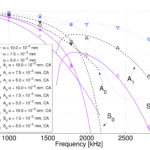Analysis of elastic wave propagation in nonlinear media has gained recent research attention due to the their attractive properties for NDT and SHM. This creates opportunities for increased accuracy of damage detection and localization, development of new structural monitoring strategies, and design of new structures with desirable acoustic behavior (e.g., amplitude-dependent frequency bandgaps, wave beaming, and filtering). Nonlinear elastic wave propagation analysis approaches target the prediction of higher harmonic growth, wave-wave interactions and other phenomena. As shown in [] nonlinear guided waves exhibit also amplitude-dependent properties, which in turn result in shifts in Lamb wave dispersion curves.
Typically, dispersion curves are calculated for nominally linear material parameters and geometrical features of a waveguide, even when the constitutive law is nonlinear. Instead, in our work we employ perturbation approaches, e.g. a Lindstedt – Poincaré perturbation approach, to calculate amplitude- dependent dispersion curves, and shifts thereof, for nonlinearly-elastic plates. As a result, a set of first order corrections to frequency (or equivalently wavenumber) are calculated. These corrections yield significant amplitude dependence in the spectral characteristics of the calculated waves, especially for high frequency waves, which differs fundamentally from linear analyses. Numerical simulations confirm the analytical shifts predicted. Recognition of this amplitude-dependence in Lamb wave dispersion may suggest, among other things, that the analysis of guided wave propagation phenomena within a fully nonlinear framework needs to revisit mode-mode energy flux and higher harmonics generation conditions.

